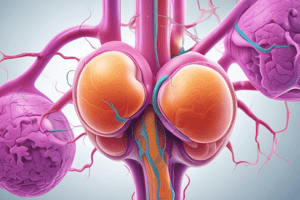Podcast
Questions and Answers
What is the primary purpose of a urine culture and sensitivity test in the context of urinary tract infections?
What is the primary purpose of a urine culture and sensitivity test in the context of urinary tract infections?
- To measure creatinine clearance
- To identify the presence of renal stones
- To determine the bacteria’s susceptibility to antibiotics (correct)
- To assess the acidity of urine
What component of the urinary system helps maintain a typically sterile environment?
What component of the urinary system helps maintain a typically sterile environment?
- Acidic pH of urine (correct)
- Renal scan
- Kidneys
- Urethra
In the context of urinary tract infections, what does the presence of leukocyte esterase indicate?
In the context of urinary tract infections, what does the presence of leukocyte esterase indicate?
- Indication of pyuria (correct)
- Normal kidney function
- Presence of blood in urine
- Renal failure
Which antibiotic is typically used for the treatment of uncomplicated or initial urinary tract infections?
Which antibiotic is typically used for the treatment of uncomplicated or initial urinary tract infections?
What is the purpose of a 24-hour urine specimen analysis in assessing renal function?
What is the purpose of a 24-hour urine specimen analysis in assessing renal function?
What may tenderness during renal percussion indicate?
What may tenderness during renal percussion indicate?
Which nursing diagnosis would be appropriate for a patient with urinary tract issues?
Which nursing diagnosis would be appropriate for a patient with urinary tract issues?
During a health promotion initiative, patients should be encouraged to drink how much fluid daily?
During a health promotion initiative, patients should be encouraged to drink how much fluid daily?
Which of the following is NOT a recommended intervention to prevent urinary tract infection recurrence?
Which of the following is NOT a recommended intervention to prevent urinary tract infection recurrence?
What should the patient be able to do upon evaluation if their UTI treatment is effective?
What should the patient be able to do upon evaluation if their UTI treatment is effective?
Which antibiotic is commonly used to treat uncomplicated UTIs?
Which antibiotic is commonly used to treat uncomplicated UTIs?
What is a potential adverse reaction when using fluoroquinolones?
What is a potential adverse reaction when using fluoroquinolones?
How often is Macrobid, the long-acting preparation of Nitrofurantoin, typically administered?
How often is Macrobid, the long-acting preparation of Nitrofurantoin, typically administered?
What is the primary use of Phenazopyridine (Pyridium) in urinary tract treatment?
What is the primary use of Phenazopyridine (Pyridium) in urinary tract treatment?
Which of the following is NOT a subjective data point in nursing assessment for urinary conditions?
Which of the following is NOT a subjective data point in nursing assessment for urinary conditions?
What discoloration can Phenazopyridine cause in urine?
What discoloration can Phenazopyridine cause in urine?
What is a common complication of untreated urinary stasis due to a sedentary lifestyle?
What is a common complication of untreated urinary stasis due to a sedentary lifestyle?
Which of the following would be assessed under the cognitive-perceptual pattern during a nursing assessment?
Which of the following would be assessed under the cognitive-perceptual pattern during a nursing assessment?
Flashcards are hidden until you start studying
Study Notes
Elimination Concept
- Elimination involves the removal of waste products from the body, specifically related to the renal and urinary systems.
- The renal system includes two kidneys, while the urinary system comprises two ureters, a bladder, and a urethra.
Genitourinary System Review
- Functions of the Renal System:
- Maintains fluid volumes and regulates blood pressure.
- Monitors urine for leukocyte esterase, indicating pyuria and possible urinary tract infection (UTI).
- Urine Analysis:
- Cultures identify bacteria's susceptibility to antibiotics, crucial for persistent or recurrent UTIs.
- 24-hour urine specimen analysis approximates Glomerular Filtration Rate (GFR) based on creatinine clearance.
Drug Therapy for UTIs
- Antibiotics:
- Trimethoprim/Sulfamethoxazole (TMP/SMX) is commonly used for uncomplicated UTIs; resistance is increasing.
- Nitrofurantoin is taken 3-4 times a day; long-acting formulations are taken twice daily.
- Other options include ampicillin, amoxicillin, and cephalosporins.
- Fluoroquinolones like ciprofloxacin treat complicated UTIs but carry risks of tendonitis.
- Urinary Analgesics:
- Phenazopyridine (Pyridium) provides relief for urinary tract discomfort and may stain urine reddish-orange.
Nursing Assessment
- Subjective Data Collection:
- Assess past health history, nephrotoxic medications, and surgeries.
- Evaluate functional health patterns, including nutrition, elimination habits, activity levels, sleep, cognition, and self-perception.
- Objective Data Collection:
- Perform physical inspections on skin and oral mucosa for edema.
- Auscultate bowel sounds and palpate for kidney tenderness or bladder distension.
Nursing Diagnosis and Planning
- Common nursing diagnoses include impaired urinary elimination and readiness for enhanced self-management.
- Expected outcomes include relieving lower urinary tract symptoms and preventing upper tract involvement.
Nursing Implementation
- Acute Interventions:
- Encourage increased fluid intake (2-3L daily) and proper hygiene practices.
- Maintain adherence to antibiotic regimens.
- Health Promotion:
- Educate on voiding every 3-4 hours, proper peri-care, and dietary adjustments to limit irritants like caffeine, alcohol, and spicy foods.
- Encourage cranberry products and recommend urination before and after sexual activity for women.
Nursing Evaluation
- Monitor for normal urinary elimination patterns and relief from symptoms.
- Ensure the patient verbalizes an understanding of their treatment plan and regimens.
Studying That Suits You
Use AI to generate personalized quizzes and flashcards to suit your learning preferences.




